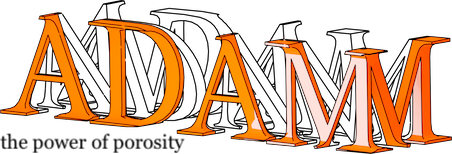ANALYSIS, DESIGN And MANUFACTURING using MICROSTRUCTURES
funded by the H2020 Horizon programme of the European Union
 The geometric computer aided design (CAD) field is on the brink of a major leap with a rapidly increasing demand for more efficient, accurate and controllable manufacturing processes as well as the evolution of new manufacturing technologies. To manufacture a complex curved 3D shape, such as a turbine blade or a 3D scanner portable mechanism, requires powerful and user-friendly Analysis, Design, And Manufacturing (ADAM) tools that operate under tight synergy and efficiently and automatically create 3D artefacts. The evolution of new manufacturing technologies such as multi-material 3D printers gives rise to new type of objects that may consist of considerably less, yet heterogeneous, material, consequently being porous, lighter and cheaper, while having the very same functionality as the original object when manufactured from one single solid material. We propose a unified manufacturing pipeline that will focus on all stages involving Analysis, Design, And Manufacturing using Microstructures (ADAM2>).
The geometric computer aided design (CAD) field is on the brink of a major leap with a rapidly increasing demand for more efficient, accurate and controllable manufacturing processes as well as the evolution of new manufacturing technologies. To manufacture a complex curved 3D shape, such as a turbine blade or a 3D scanner portable mechanism, requires powerful and user-friendly Analysis, Design, And Manufacturing (ADAM) tools that operate under tight synergy and efficiently and automatically create 3D artefacts. The evolution of new manufacturing technologies such as multi-material 3D printers gives rise to new type of objects that may consist of considerably less, yet heterogeneous, material, consequently being porous, lighter and cheaper, while having the very same functionality as the original object when manufactured from one single solid material. We propose a unified manufacturing pipeline that will focus on all stages involving Analysis, Design, And Manufacturing using Microstructures (ADAM2>).
Additive manufacturing (AM) techniques allow for the manufacturing of volume components using microstructures, leading to a number of advantages, for example regarding light-weight design or multi-material products. At the same time, AM not only supports, but can also benefit from porous microstructure, improving upon efficiency. For engineers, the microstructural design is difficult to handle, as they typically have little intuition that will help in the design. We will develop numerical analysis and optimization tools that will assist the engineer in the design of the whole part, and especially the related microstructure(s).
In recent years, interest in porous geometry is on the rise, mostly due to the introduced ability to fabricate and manufacture highly complex porous objects, using additive manufacturing technologies (i.e. 3D printers). Recently, an ability was introduced by one of the PIs to precisely synthesize freeform repetitive parametric micro-elements as complete microstructure of arbitrary freeform shapes. The synthesized geometry can be heterogeneous using a volumetric geometric modelling representation (V-rep) and is fully compatible with contemporary boundary representation (B-rep) design and modern (iso-geometric) analysis tools. We will explore the full potential of this recently-proposed methodology.
Manufacturing processes for curved geometries designed in WP1 will include machining processes, also known as Subtractive Manufacturing (SM), and, Additive Manufacturing (AM) processes. This two existing technologies, 5-axis SM and new multi-axis AM into Hybrid Manufacturing (HM), will be combined in order to use only one methodology to manufacture complicated microstructures. The additive part will be used first to produce the rough structure, while the subtractive counterpart will be applied in the (semi-)finishing stage. Moreover, Biomachining manufacturing process, an environmentally-friendly manufacturing methodology that uses bacteria to eliminate microscopic residues of material, will also be performed for finishing operations. Recent methodology designed by one of PIs will be performed for the use extremophile bacteria for the polishing stage of the microstructured objects.
Design of porous and lattice-like structures goes along with the blossoming of additive manufacturing technology. These structures exist and are designed using specific type of micro-elements with minimal (or no) control over physical properties of the designed objects. Furthermore their manufacturing is a complex procedure that is accomplished using a specific sequence of steps that are associated with one particular type of microstructure, leading to one particular manufacturing algorithm. In contrast, ADAM2 proposes a unified methodology that will further strengthen the use of microstructures. To the best of our knowledge, the optimal layout of the internal parameterized micro-elements in freeform microstructure, the ability to design and to analyze them, as well as its manufacturing using hybrid machining (3D printing and 5-axis CNC machining) is radically new. Consequently, ADAM2 offers a geometric modeling framework for the 21st century that will allow for design, analysis, optimization, and manufacturing of highly complex porous and microstructured heterogeneous geometries.

